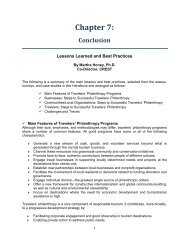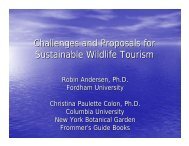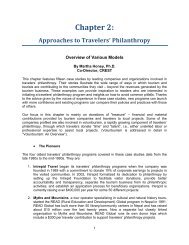Travelers' Philanthropy Handbook - Center for Responsible Travel
Travelers' Philanthropy Handbook - Center for Responsible Travel
Travelers' Philanthropy Handbook - Center for Responsible Travel
Create successful ePaper yourself
Turn your PDF publications into a flip-book with our unique Google optimized e-Paper software.
heading with travelers’ philanthropy. At least seven key words seem important to highlight andremember as we move ahead:1. ComplexityRecognize Complexity be<strong>for</strong>e Generality – social fabric and ecosystem design is seldom assimple and straight<strong>for</strong>ward as it often seems at the onset of a project.2. PartnershipAim <strong>for</strong> Partnership be<strong>for</strong>e Individual – be careful in entering a development or conservationproject without defining the crucial partnerships where adequate knowledge and professionalexperience is secured in relation to the project goals.3. InvestmentConsider Investment be<strong>for</strong>e Charity – in order to achieve deep felt effect and lastingtrans<strong>for</strong>mation in the society, the idea of looking at philanthropy as investment with an expectedreturn (ROI) is becoming more and more common. The chart at the end of this section brieflydescribes the thinking around innovation, trans<strong>for</strong>mation, and investment levels in travelers’philanthropy.4. Sustainable ChangePrepare <strong>for</strong> Sustainable Change be<strong>for</strong>e Status Quo – the point of developing and operatingcommunity and conservation projects is not to provide <strong>for</strong> the status quo. The very point of theproject should be to create lasting change -- trans<strong>for</strong>mation. And remember, if your organizationdoes not change and develop over time along with its projects, it is unlikely it will deliver thechange it is seeking.5. ProactiveBe Proactive be<strong>for</strong>e Reactive – leadership requires clear vision and direction. As soon as welose sight of what we are actually trying to achieve through trans<strong>for</strong>mation in the society, thework becomes reactive. Need driven philanthropy is hopefully an answer to a felt need in thesociety and it should always be cautious of becoming a treatment rather than a way out of anunsustainable pattern. Help to self-help may be a slow process, but it has almost always provento be more efficient and effective in creating lasting change. However, if being proactive is thepreferred approach, it should not hinder the provision of much needed relief projects whendisasters occur. There is good reason <strong>for</strong> both approaches.6. Long TermThink Long-term be<strong>for</strong>e Event – the aspects of time has been discussed in previous sections. Itis worthwhile pointing at the opportunity of attaching the project’s time perspectives to theperspective of business investments. One of the most efficient ways of protecting a tourisminvestment locally is to invest in the local community and surrounding environment. Hence,there is little reason to look at short-term development projects, and all the reason to takeadvantage of the long-term presence of the business <strong>for</strong> developing deeply felt, resilient, andtrans<strong>for</strong>mative projects, all of which require time.7. ProfessionalBalance Professional against Interest – the “feel-good” factor and personal interest inphilanthropy versus professional approach and intelligent decision-making is a bit like a doubleedgedsword. Both sides of the blade need to be worked on to create a sharp, durable, andfunctional tool. If there is an imbalance, there is also a risk that travelers’ philanthropy eitherbecomes nothing more than an academic exercise or harmful handouts.135















